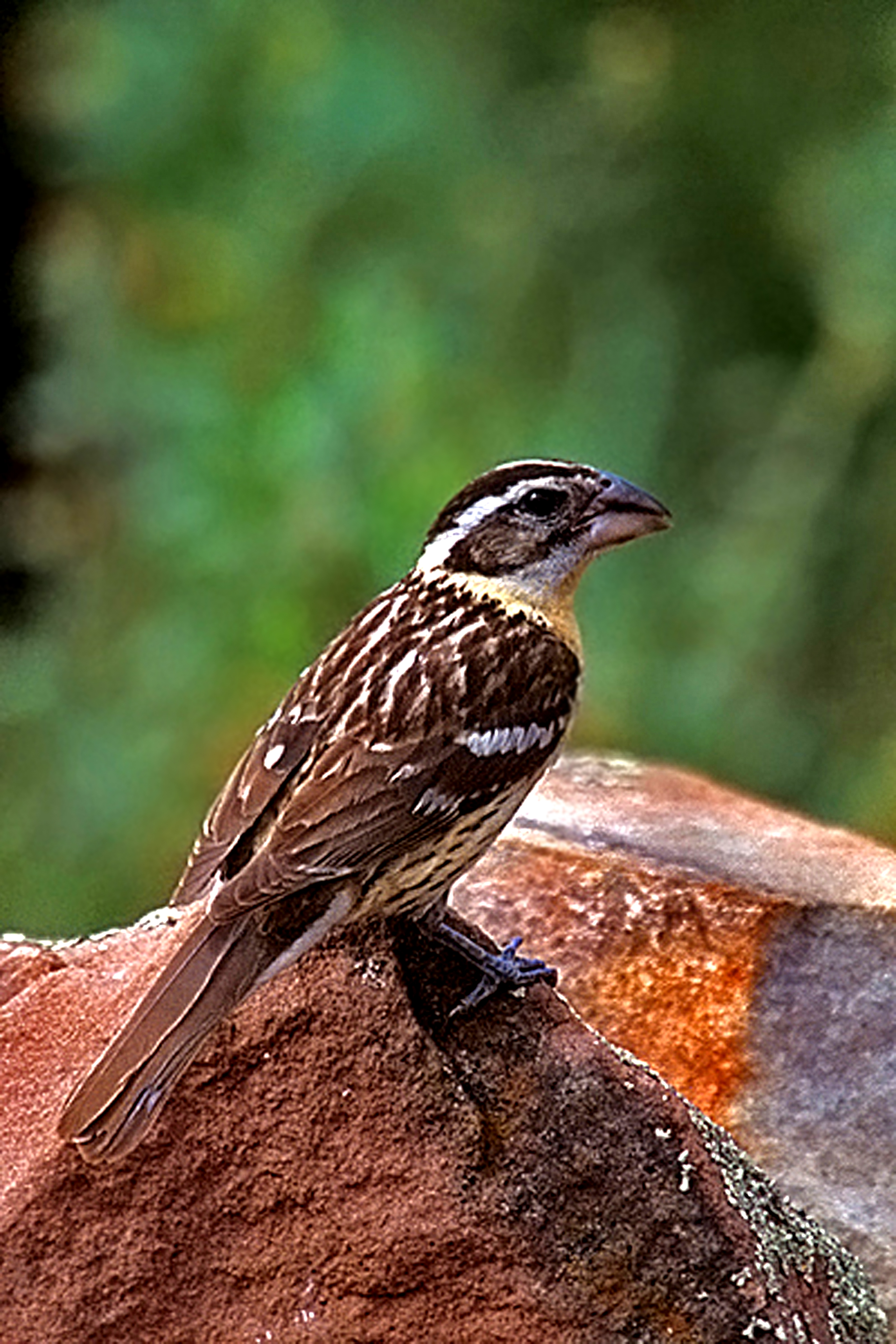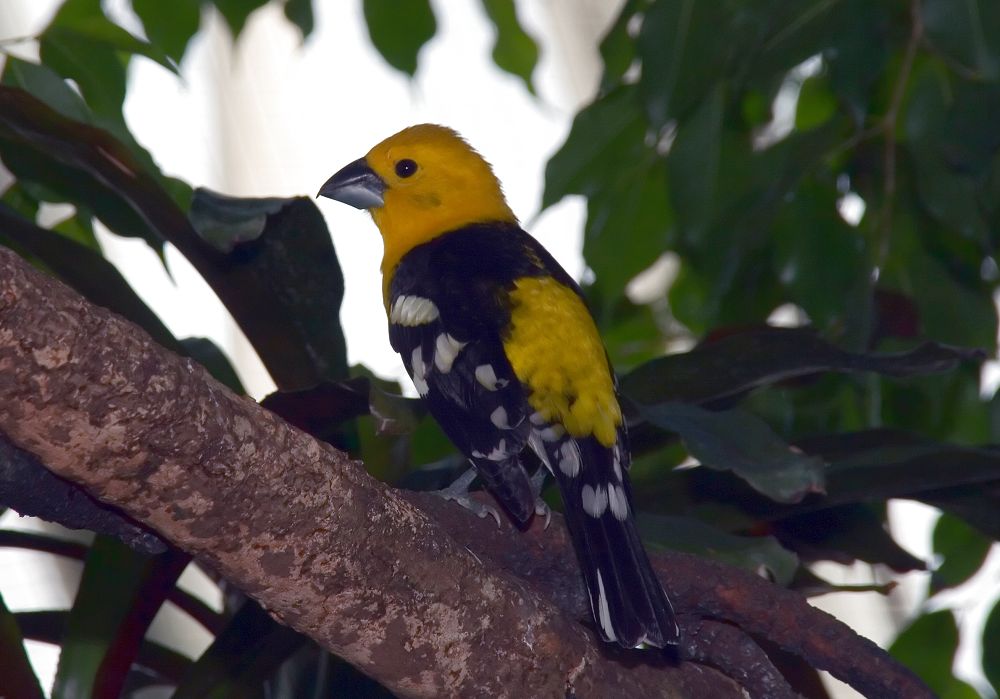|
Pheucticus
''Pheucticus'' is a genus of grosbeaks containing six species. The genus was introduced by the German naturalist Ludwig Reichenbach in 1850. The type species was subsequently designated as the black-backed grosbeak. Species The name of the genus is from the Ancient Greek Ancient Greek includes the forms of the Greek language used in ancient Greece and the ancient world from around 1500 BC to 300 BC. It is often roughly divided into the following periods: Mycenaean Greek (), Dark Ages (), the Archaic p ... φευκτικός - ''pheuktikós'' "shy" or "inclined to avoid". References Bird genera Grosbeaks Taxa named by Ludwig Reichenbach {{Ploceidae-stub ... [...More Info...] [...Related Items...] OR: [Wikipedia] [Google] [Baidu] |
Rose-breasted Grosbeak
The rose-breasted grosbeak (''Pheucticus ludovicianus''), colloquially called "cut-throat" due to its coloration, is a large, seed-eating grosbeak in the cardinal family (Cardinalidae). It is primarily a foliage gleaner. Males have black heads, wings, backs, and tails, and a bright rose colored patch on their white breast. Males and females exhibit marked sexual dimorphism. Breeding habitat consists of cool-temperate open deciduous woods throughout much of eastern North America, with migration to tropical America in winter. Rose-breasted grosbeaks have an average maximum lifespan of 7.3 years in the wild, and up to 24 years in captivity. Death in the wild is generally due to collision with objects (buildings, cars, etc.) and predation, to eggs, nestlings and adults. Taxonomy In 1760 the French zoologist Mathurin Jacques Brisson included a description of the rose-breasted grosbeak in his ''Ornithologie'' based on a specimen collected in Louisiana. He used the French name ''Le gro ... [...More Info...] [...Related Items...] OR: [Wikipedia] [Google] [Baidu] |
Black-headed Grosbeak
The black-headed grosbeak (''Pheucticus melanocephalus'') is a medium-sized, seed-eating bird in the family Cardinalidae. It is sometimes considered conspecific with the rose-breasted grosbeak (''P. ludovicianus'') with which it hybridizes on the American Great Plains. The long, black-headed grosbeak is a migratory bird, with nesting grounds from southwestern British Columbia, through the western half of the United States, into central Mexico. It occurs as a vagrant further south in Central America. Description Measurements: * Length: * Weight: * Wingspan: The black-headed grosbeak is similar in size to a common starling. As per its name, the male has a black head, and black wings and tail with prominent white patches. Its breast is dark to tawny orange in color, and its belly is yellow. The female has a brown head, neck, and back with sparrow-like black streaks. She also has white streaks down the middle of her head, over her eyes, and on her cheeks. Her breast is whi ... [...More Info...] [...Related Items...] OR: [Wikipedia] [Google] [Baidu] |
Pheucticus Chrysogaster 3zz
''Pheucticus'' is a genus of grosbeaks containing six species. The genus was introduced by the German naturalist Ludwig Reichenbach in 1850. The type species was subsequently designated as the black-backed grosbeak. Species The name of the genus is from the Ancient Greek Ancient Greek includes the forms of the Greek language used in ancient Greece and the ancient world from around 1500 BC to 300 BC. It is often roughly divided into the following periods: Mycenaean Greek (), Dark Ages (), the Archaic p ... φευκτικός - ''pheuktikós'' "shy" or "inclined to avoid". References Bird genera Grosbeaks Taxa named by Ludwig Reichenbach {{Ploceidae-stub ... [...More Info...] [...Related Items...] OR: [Wikipedia] [Google] [Baidu] |
Black-backed Grosbeak
The black-backed grosbeak (''Pheucticus aureoventris'') is a bird in the family Cardinalidae, the cardinals or cardinal grosbeaks. It is found in Argentina, Brazil, Bolivia, Colombia, Ecuador, Paraguay, Peru, and Venezuela. They are often kept as cagebirds.Brewer, D. and E. de Juana (2020). Black-backed Grosbeak (''Pheucticus aureoventris''), version 1.0. In Birds of the World (J. del Hoyo, A. Elliott, J. Sargatal, D. A. Christie, and E. de Juana, Editors). Cornell Lab of Ornithology, Ithaca, NY, USA. https://doi.org/10.2173/bow.blbgro2.01 retrieved 19 May 2021 Taxonomy and systematics The black-backed grosbeak has five recognized subspecies: *''P. a. meridensis'' Riley (1905) *''P. a. uropygialis'' Sclater & Salvin (1871) *''P. a. crissalis'' Sclater & Salvin (1877) *''P. a. terminalis'' Chapman (1919) *''P. a. aureoventris'' d'Orbigny & Lafresnaye (1837) There is some evidence that the black-backed grosbeak may be paraphyletic with respect to golden grosbeak (''Pheuct ... [...More Info...] [...Related Items...] OR: [Wikipedia] [Google] [Baidu] |
Golden Grosbeak
The golden grosbeak (''Pheucticus chrysogaster''), also known as golden-bellied grosbeak or southern yellow grosbeak, is a species of grosbeak in the family Cardinalidae. It is similar to, and has sometimes been considered conspecific with, the yellow grosbeak. The golden grosbeak is found in Colombia, Ecuador, Peru, Trinidad and Tobago, and Venezuela. Its natural habitats are subtropical or tropical dry forests, subtropical or tropical moist montane forests, subtropical or tropical dry shrubland, and heavily degraded former forest. Taxonomy The golden grosbeak belongs to the taxonomic family Cardinalidae. Other members of this family include cardinals, buntings, and other grosbeaks. Its genus, '' Pheuticus'' (meaning "shy" in Greek), contains six extant species. The golden grosbeak (''P. chrysogaster'') used to be considered a member of the same species as the black-thighed grosbeak (''P. tibialis'') and yellow grosbeak (''P. chrysopeplus''); collectively, they went under ... [...More Info...] [...Related Items...] OR: [Wikipedia] [Google] [Baidu] |
Yellow Grosbeak
The yellow grosbeak (''Pheucticus chrysopeplus''), also known as the Mexican yellow grosbeak, is a medium-sized seed-eating bird in the same family as the northern cardinal, "tropical" or "New World" buntings, and "cardinal-grosbeaks" or New World grosbeaks. The yellow grosbeak occurs on the Pacific slope of Mexico from central Sonora to northwestern Oaxaca, and in southern Chiapas and Guatemala. In Sonora, it is migratory. It has been considered conspecific with ''P. tibialis'' of Central America and '' P. chrysogaster'' of South America. It occurs mostly in trees in forest, woodland, and edge, but is generally not found in dense rain or cloud forests. Occasional vagrants have reached the United States, mostly in summer in Arizona, but it has also been reported in California, Colorado, New Mexico, and even Iowa. It is considerably bigger than its North American congeners, the black-headed grosbeak and the rose-breasted grosbeak, being about long and weighing on average . Th ... [...More Info...] [...Related Items...] OR: [Wikipedia] [Google] [Baidu] |
Black-thighed Grosbeak
The black-thighed grosbeak (''Pheucticus tibialis'') is a large seed-eating bird in the cardinal family, which is endemic to the mountains of Costa Rica and western Panama. This species breeds from about altitude (Pacific slope) or ( Caribbean slope) up to and is found in canopy, woodland edge and semi-open habitats such as pasture with some trees. The nest is a thin cup constructed on a bulky twig base up in a small tree or amongst vines. The female lays two brown-spotted pale blue eggs between March and May. The adult black-thighed grosbeak is long, weighs , and has a massive grey bill. The male has a yellow head, rump and underparts, an olive-edged black back, and black wings, thighs and tail. There is a white patch on the flight feathers. The female is paler with more olive on the back and a smaller white wing patch. Immatures are duller and more olive-tinged, and have streaking and mottling on the body plumage. The black-thighed grosbeak forages in shrubs or trees fo ... [...More Info...] [...Related Items...] OR: [Wikipedia] [Google] [Baidu] |
Grosbeak
Grosbeak is a form taxon containing various species of seed-eating passerine birds with large beaks. Although they all belong to the superfamily Passeroidea, these birds are not part of a natural group but rather a polyphyletic assemblage of distantly related songbirds. Some are cardueline finches in the family Fringillidae, while others are cardinals in the family Cardinalidae; one is a member of the weaver family Ploceidae. The word "grosbeak", first applied in the late 1670s, is a partial translation of the French ''grosbec'', where ''gros'' means "large" and ''bec'' means "beak". The following is a list of grosbeak species, arranged in groups of closely related genera. These genera are more closely related to smaller-billed birds than to other grosbeaks. Exceptions are the three genera of "typical grosbeak finches", which form a group of closest living relatives and might thus be considered the "true" grosbeaks. Grosbeak finches The finch family (Fringillidae) contains ... [...More Info...] [...Related Items...] OR: [Wikipedia] [Google] [Baidu] |




